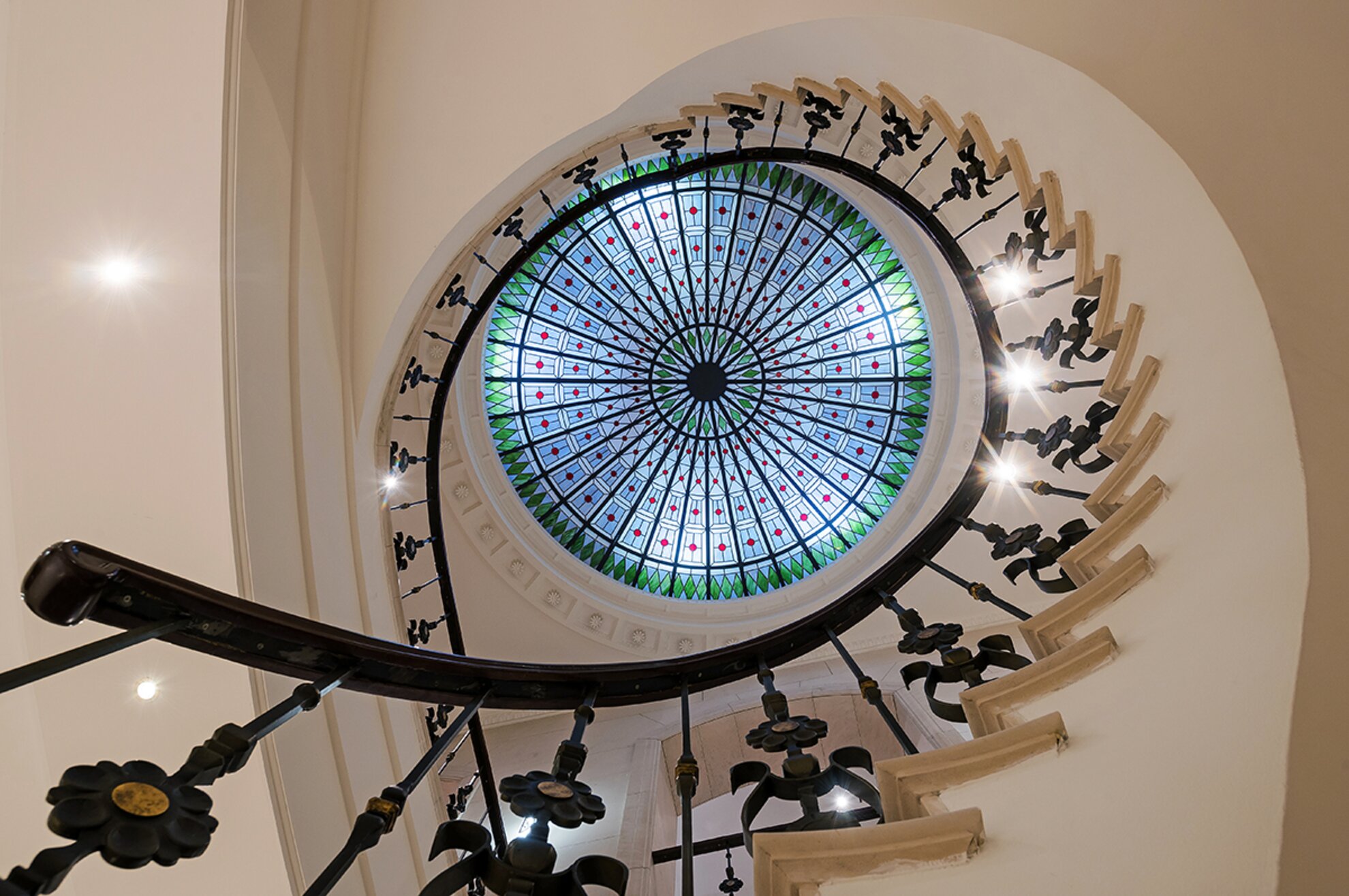With his latest series of images, renowned local photographer Krisztián Bódis invites you on a head-swirling tour around town. The lensman presents Budapest’s dazzling domes adorned with vibrant design that sometimes remain unnoticed by visitors who don’t look up while exploring the city’s landmarks. These recently taken pictures by Bódis cover buildings that have been enhanced with captivating cupolas, including museums, churches, baths, and many semi-hidden destinations.

This gilded atrium is considered the crown jewel of the neo-Gothic Parliament. Artworks depicting prominent monarchs of Magyar history stand below the 27-meter-high ceiling, while the dome hall is home to a much revered national relic, the Holy Crown of Hungary.

The whitewashed building of the National Museum hides a colorful interior complete with a pink-hued dome that is reminiscent of fairy-tale settings appearing in a Wes Anderson movie.

While the Hungarian State Opera is currently undergoing renovation, after the works are completed the decorative auditorium will be open again for performances. During stage shows guests can admire fascinating frescoes by prominent painter Károly Lotz, featuring Olympus from Greek mythology.

Built by acclaimed Hungarian architect Ödön Lechner, the Museum of Applied Arts prompted a public outcry for its vibrant design when it first opened its doors. The building was considered flamboyant and it was often referred to as the Maharaja’s palace.

Home to 18 pools, the Széchenyi Baths are one of Europe’s largest thermal-spa facilities. Besides healing amenities, the neo-Baroque construction also provides an aesthetic escapade with its stately design presented on the ceiling to feature themes related to water and rejuvenation.

A spectacular monument at Budapest Zoo since 1912, the Elephant House displays Art-Nouveau style fused with Indian and African elements to highlight the origin of the building’s residents. Fancy tilework embellishes the interior to portray elephants, hippos and rhinos.

The ornate city passage of Párisi Udvar is currently being transformed into a palatial lodging. The building’s glass atrium has temporarily been removed for renovation and after getting a makeover, the cupola will shelter the lobby and several restaurants of the hotel.

Monumental St. Stephen’s Basilica features a massive dome soaring 96 meters high, further elevated by artworks portraying celestial scenes. It took 54 years to put up this hallowed shrine and the current cupola is the second atrium at the Basilica as the first one collapsed in 1868 due to construction errors.

Found in Budapest’s District VII, the stately Synagogue on Rumbach Sebestény utca is one of the city’s most colorful attractions. Designed by Viennese Art-Nouveau architect Otto Wagner, this Moorish-style landmark is currently not accessible to the public while the building receives a long-term a revamp.

Hungary’s biggest Jewish cemetery on Kozma Street in District X provides the final resting place for notable Hungarians, including Olympic swimming champion Alfréd Hajós and notable author Sándor Bródy. Opened in 1893, this gigantic graveyard has several Art-Nouveau crypts festooned with bright mosaic works.

Kerepesi Cemetery is where you find the magnificent mausoleums among numerous smaller burial sites of historic Hungarians, including revolutionary statesman Lajos Kossuth and prolific poets Endre Ady and Attila József.

The astounding atrium of the century-old Gellért Baths bears Art Nouveau attributes, while the overall interior design of this solemn soaking space blends Hungarian folk motifs with Eastern influences. Meanwhile, the spa’s walls are covered in the distinctive turquoise tiling of the famed Zsolnay factory in Pécs.

Registered as Budapest’s oldest spa, the Király Baths were built during the Ottoman era. It was reconstructed several times, but the arched ceiling of the Turkish bath still features its 16th-century design with light infiltrating through the tiny windows enhancing the dome.

Designed by Miklós Ybl of Opera House fame, the riverfront Várkert Bazaar lies beneath Buda Castle. The 19th-century neo-Renaissance palace features Zsolay tiles, elaborate glasswork and cast-iron décor under its brightly lit cupola.

An iconic sight of Budapest cityscape, the monumental dome was mounted on the Royal Palace in the 1960s to restore the building that was severely damaged during World War II. Under this contemporary arcade, visitors can now view exhibitions held at the Hungarian National Gallery.

Located directly beside Pest’s focal Deák tér, the elegant urban palace that now houses The Ritz-Carlton, Budapest was originally built as a deluxe downtown office for the Adriatic Insurance Company and later served as the city’s police headquarters throughout Hungary’s era under Soviet control. Inside the elaborate edifice, finely crafted stained-glass cupolas elevate the hotel’s splendor.

The semi-abandoned Kelenföld Power Station is a true hidden gem of Budapest’s Art-Deco architecture. The control room is covered with a round-shaped glass roof that gives an otherworldly feel to the industrial complex.
These masterfully captured images show that some of the city's most spectacular sights often lie above eye level.




